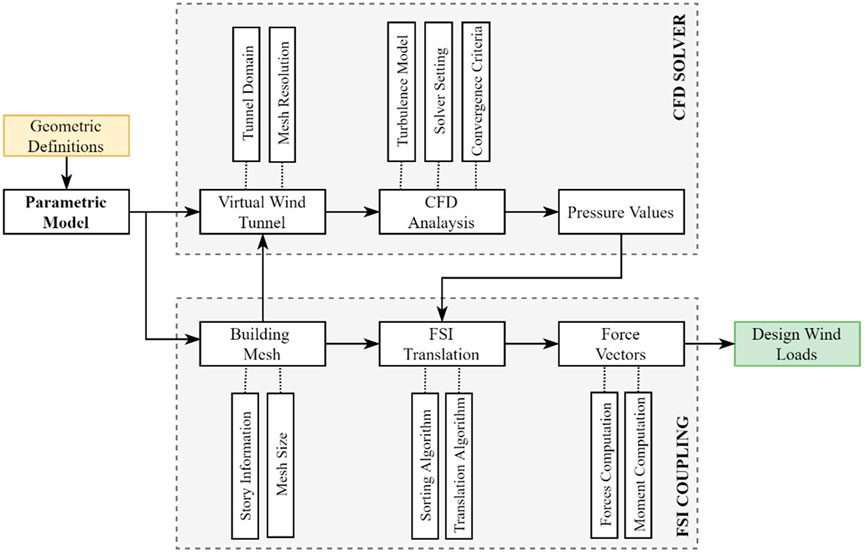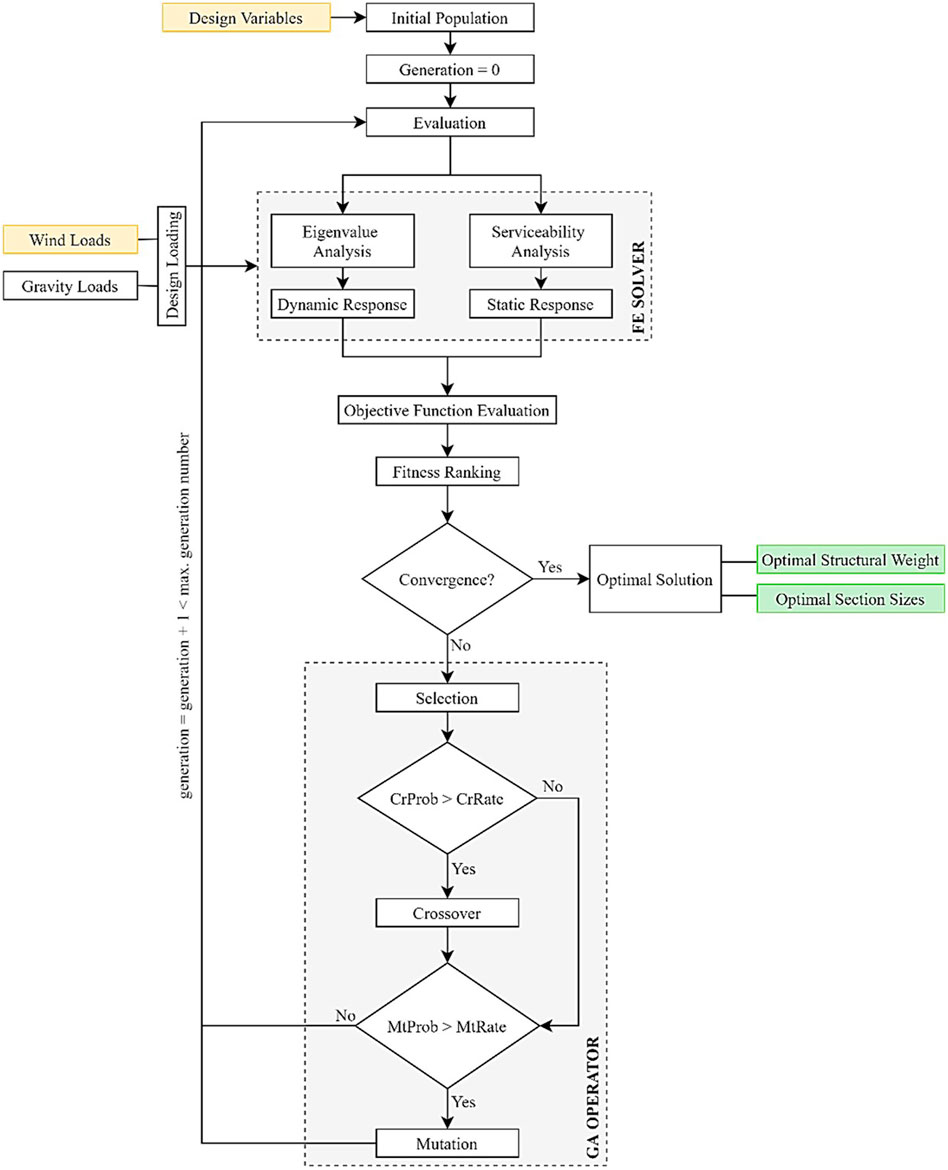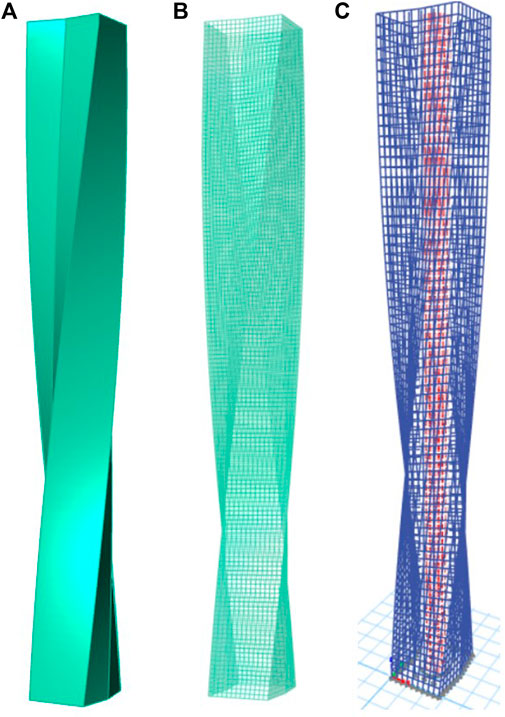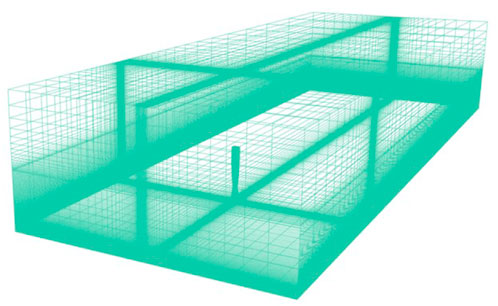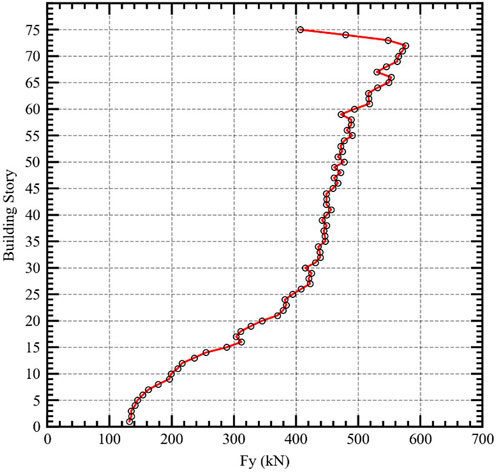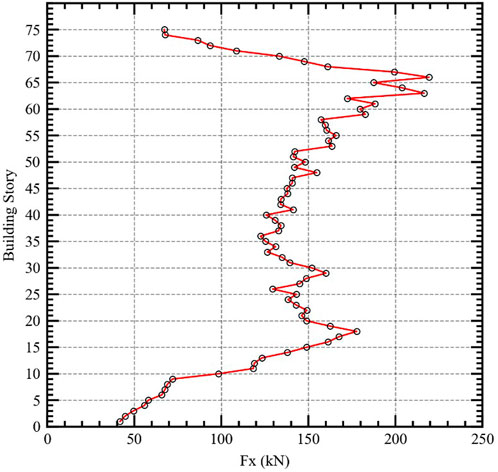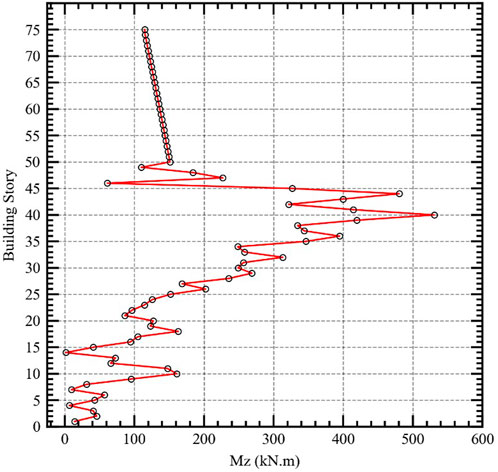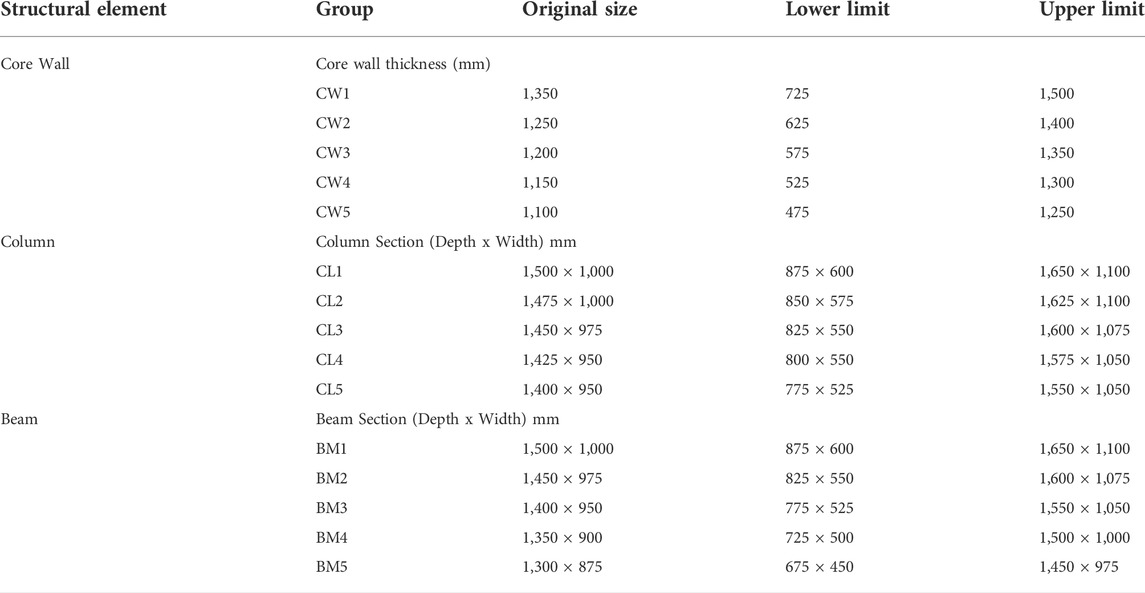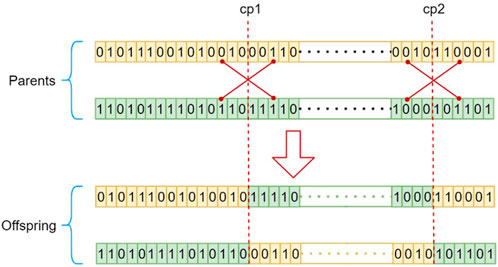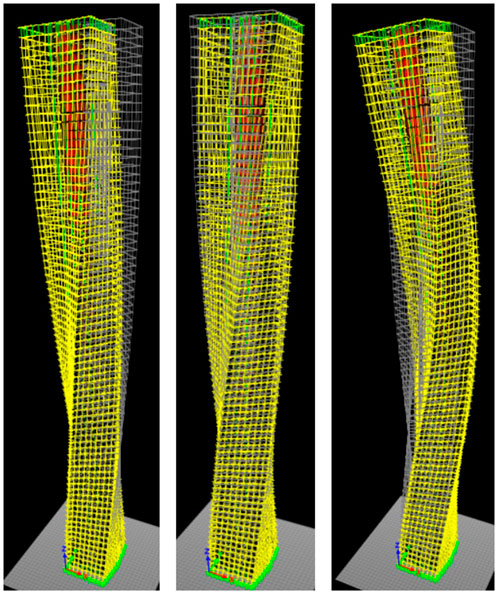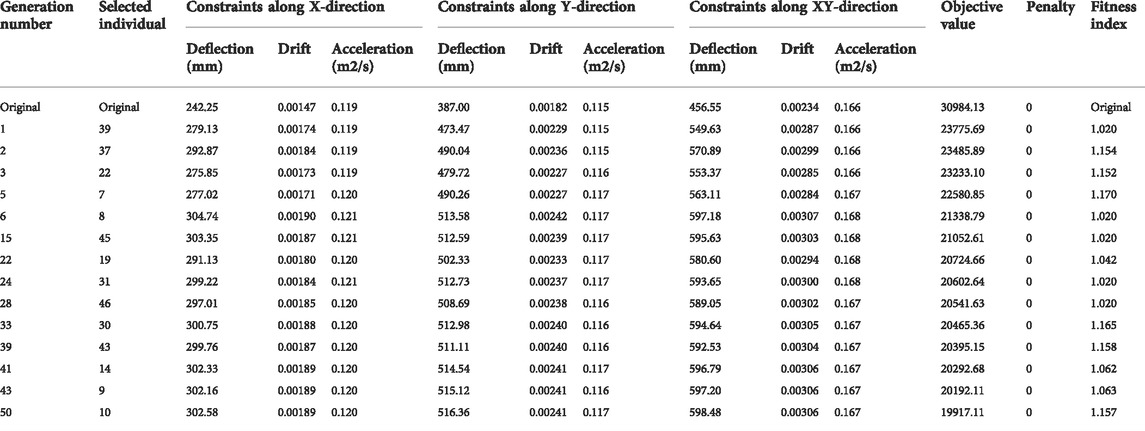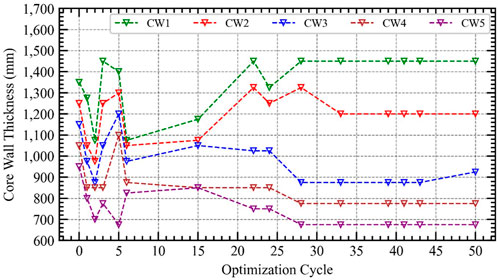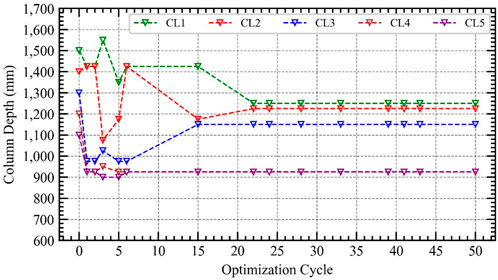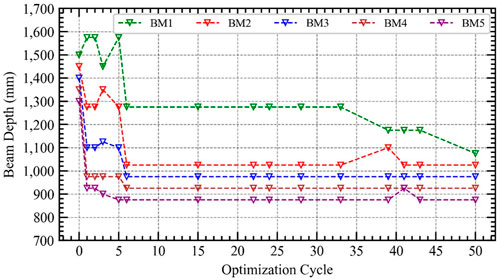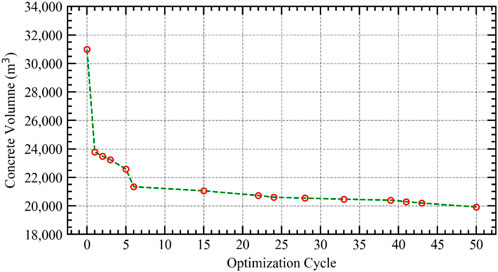- 1Department of Structural Engineering, Faculty of Civil Engineering and Built Environment, Universiti Tun Hussein Onn Malaysia (UTHM), Parit Raja, Johor, Malaysia
- 2Faculty of Technology Management and Business, Universiti Tun Hussein Onn Malaysia (UTHM), Parit Raja, Johor, Malaysia
- 3Department of Civil Engineering, College of Engineering, University of Duhok, Duhok, Iraq
- 4Department of Civil Engineering, College of Engineering, Nawroz University, Duhok, Iraq
- 5Department of Civil Engineering, Zakir Husain Engineering College, Aligarh Muslim University, Aligarh, India
- 6World-class Research Center of Advanced Digital Technologies, Peter the Great St. Petersburg Polytechnic University, St. Petersburg, Russia
Tall buildings with irregular shapes and considerable heights are gaining popularity in creating the vertical cities around the world. They also considered one of the major energy consumers with little regards to sustainability. Tall building is wind-sensitive structure and shape plays major role in determining wind loads, which usually govern the design of its lateral resisting system. Thus, evaluating wind loads properly and designing an optimal lateral system accordingly are the main challenges attributed to the design process of irregular tall building. This paper presents a computational procedure for the optimal design of wind-resistant irregular tall building to minimize the total weight of structure within design requirements in single digital environment. That is achieved firstly by creating a digital system of computational fluid dynamic (CFD) analysis that is coupled with pressure-load translation (PLT) algorithm to evaluate the wind motions on irregular tall buildings and generate the design wind loads accordingly. Genetic Algorithm (GA) with enhance design constrains function of lateral displacements, inter-story drifts and top acceleration is then developed to perform structural optimization. A numerical example using 70-story twisting reinforced concrete building is implemented to verify the feasibility of the developed computational procedures. Steady and incompressible flow applied at (
1 Introduction
Social and economic accelerating development, together with new engineering and construction techniques have inspired architects and engineers to design atypical, complex and slender tall buildings to reflect their creativity and innovation (Alkhatib et al., 2021a). These developments are associated with complexity in wind-induced motions and its attributed structural factors such as low natural frequency, lack of sufficient damping and increment in flexibility and slenderness (Sharma et al., 2018), where wind-induced forces usually govern the design of tall building (Elshaer et al., 2017). Thus, finding a balance between safety, serviceability and economy has been a challenge faced by architects and engineers when designing modern irregular tall buildings. This challenge is leveled up when sustainability factor is added into the equation by producing energy-efficient design.
Because building shapes plays critical role in deriving its aerodynamic characters, modification of tall building forms proved to be effective in mitigating wind-induced loads on tall buildings (Xie, 2014; Elshaer et al., 2017). Several studies investigated different aerodynamic modifications on tall buildings including major modifications such as tapering, twisting and setback (Kim and You, 2002; Kim et al., 2008; Xie, 2014; Bairagi and Dalui, 2018) that have a significant impact architecturally and structurally on building design, or minor modifications such as corner configuration (Zhengwei et al., 2012; Li et al., 2018; Thordal et al., 2020; Mandal et al., 2021), where it has little to no effect on the intent design, yet still shows an effective results in reducing wind responses. While Kim and You (Kim and You, 2002) and Xie (Xie, 2014) found that tapering is more effective in mitigating across-wind responses, Xie (Xie, 2014) further explored twisting shape modification demonstrating that it has and extra advantage of equalizing winds distribution and responses along wind directions. Minor corner modifications, including rounding, chamfering and recession, were also investigated by Tamura et al. (Tamura et al., 1998) and Elshaer et al. (Elshaer et al., 2017) and founded to be effective in reducing wind responses. Li et al. (Li et al., 2018) demonstrated that chamfered corners resulted in an effective reduction of a long-wind loads and recessed corners showed similar effectiveness in reducing across-wind responses, but Mandal et al. (Mandal et al., 2021) proved that rounded corners are more effective in reducing wind loads than chamfered ones. Alkhatib et al. (Alkhatib et al., 2022a) introduced a new computational method to optimize wind loads on irregular tall buildings with minor aerodynamic modifications to the external shape of the buildings. Touloupaki et al. (Atabay, 2009), in the other hands, proposed a parametrical approach to minimize energy consumption of tall building by altering its geometrical form. Hassanli et al. (Hassanli et al., 2018) and Ruiz et al. (Ruiz et al., 2021) investigated the effectiveness of tall building aerodynamic treatements to wind energy harvesting by incorporating wind power system directly into the built environment. Although these studies present a valuable insight by exploiting computational methods to evaluate wind motions on tall buildings properly, altering building configuration is not architecturally and structurally preferred.
Quite the opposite, structural optimization does not rely on the changing of the building external geometries or requires additional cost. However, most of previous research work of structural optimization focused on seismic loading, with little regard to wind loading (Huang et al., 2015; Fu et al., 2018; Alkhatib et al., 2022b). In that context, Chan et al. (Chan and Chui, 2006; Chan et al., 2009) developed a set of structural optimization methods based on Optimally Criteria (OC) for optimal design of tall buildings subjected to wind actions and constraints. Huang (Ming-feng, 2013) as well, proposed a performance-based design approach by employing OC for developing optimal structural design of tall building satisfying wind-resistance requirements. However, Fu (Fu et al., 2018) demonstrated that employing OC approach may lead to inaccurate result of frequency constraint because strain energy does not account for the gradient of internal forces to its design variables and proposed an eigen value approach for computing the sensitivity of frequency constraints. Moreover, OC requires wind-induced constrains to be explicitly expressed in complicated mathematical formulas, making it not practically applicable for industrial application. Additionally, dealing with complex and large-scale models, structural response is naturally a non-linear function to the design variables and OC may not lead to discrete solutions and may trapped into local optima. It is also observed that most of the optimization techniques used today for solving engineering problems accept the design variables to be “continuous” and such characteristics cannot be employed in all engineering problems. For architectural problems, besides the mathematical formulation techniques, using “discrete” variables based algorithm is often deemed necessary (Atabay, 2009; Abd Elrehim et al., 2019).
Taking these interesting studies as a benchmark for this research to address their shortcoming, this study presents a new integrated approach for wind-induced structural optimization of irregular tall building within single digital environment. In the first place, a computational fluid dynamic (CFD) system coupled with pressure-load translation (PLT) algorithm is developed to evaluate wind motions on irregular tall building and generate the corresponding design wind loads. Next in order, structural optimization strategy is developed using Genetic Algorithm, with its ability for global search and efficient parallelism, to find the optimal weight of the structure. More importantly, because lateral drifts and top acceleration are the focus in the design of wind-resistance tall building, an enhanced design constrains penalty function is developed and integrated within GA process. Static and dynamic characteristics of the building are then assessed through finite element (FE) integrated solver to evaluate structural responses against design constraints pre-defined limits.
The paper is structured into 5 sections. Section 1 (this section) describes the topic under investigation and summarizes the related studies with its shortcomings to be addressed in this work. Section 2 demonstrates CFD wind loads generation and improved GA structural optimization methodologies. Section 3 verifies the proposed approaches by implementing a numerical example on real existing irregular tall building where analysis and results are presented and discussed. Finally, Section 5 draws the conclusion of this study and highlights the future recommendation for extending this research work.
2 Optimization methodology
2.1 Computational wind loads evaluation
Computational Fluid Dynamic (CFD) has recently extended its applications to architectural problems including tall building aerodynamic studies (Mou et al., 2017; Paul and Dalui, 2021; Sanyal and Dalui, 2022) and this opens an opportunity to utilize CFD in the preliminary stage to evaluate wind motions on irregular tall buildings. However, the idea in this work is to develop an integrated optimization approach where CFD output can be translated into static wind loads acting on each story of a given structure within a single environment in an automated manner. Thus, parametric modelling using Rhino3D (Rutten and McNeel, 2007) and its embedded generative design tool Grasshopper (GH) is employed firstly to generate the initial model representing the bluff body of building exterior shape. OpenFOAM (Weller et al., 1998), an open-source computational fluid dynamic solver that is widely and reliably used in academia and industry to solve computational problems, is utilized to perform the outdoor airflow analysis. However, to run OpenFOAM CFD cases within GH environment, a python wrapper for OpenFoam C++ library is used. Significant parameters to set up CFD environment are defined and evaluated to ensure proper evaluation of wind pressure on the selected building. That includes turbulence models, mesh resolutions, wind profile, wind speed and convergence criteria.
Pressure-Load Translation (PLT) algorithm is then developed to translate CFD output pressures into static wind loads. The PLT technique starts by transforming the pressure exerted by the building exterior façade mesh surfaces into vector forces with respect to its normal directions. Sorting algorithm is written by Python (vanRossum, 1995) to combine and group the collected vectors horizontally and vertically for each story height that is measured by mesh divisions. For each story, two vectors are generated to represent along-wind force (Fy) and across-wind forces (Fx) with respect to building major axis directions, while torsional moments (Mz) are computed as the output of their cross-product to the building’s centroid. Generated Forces and moments are then assigned to the diaphragm center of the structure for each respective story. The overall process of CFD optimal wind loads generation is shown in Figure 1.
2.2 GA structural optimization methodology
Because satisfying serviceability criteria become more challenging than achieving strength requirement (Chan et al., 2009), also since overall design of tall building is usually governed by lateral stiffness, the output sizes from lateral stiffness serviceability-based optimization are larger than strength based design sizes (Soegiarso and Adeli, 1997; Pezeshk et al., 2000). Hence, only serviceability requirements are employed as constraints for this optimization study, where strength constraints can be dealt with independently (Chan et al., 1995). Practically, strength and capacity design are regularly advised to be performed on a member-by-member approach, with reference to the standard code adopted (Zou and Chan, 2005).
2.2.1 Objective function
In structural design optimization, generally weight of structure is assumed to be the objective function. Considering concrete tall building structure, the objective function can be expressed as minimization of the structural lateral system concrete weigh. Thus, for a 3D structural frame consisting of I = 1,2,3 … , N types of core walls, columns and beams, and j = 1,2,3….M stories, the wind-resistance objective function is formulated as:
To minimize:
Limited to:
Where
2.2.1.1 Design constraints
General formulation of constrains function for k = 1,2,3 … ,V number of constrains, for j = 1,2,3….,M number of stories is expressed as follow:
Giving the problem of wind-resistance optimization, lateral drifts and top acceleration are expressed as the main design constraints restricting their values within recommended limits.
However, GA can only work with unconstrained optimization problem, thus, constrains were transformed into normalized form:
2.2.1.2 Fitness function
In order to calculate fitness value for each individual, and because constrains were normalized, the objective function has to be modified by a violence coefficient,
Where
The modified objective function can then be written as:
Where
Fitness factor then can be derived as:
where
3 Numerical example
Case Study: Cayan tower in Dubai, as shown in Figure 3, the tallest twisting tower in the world, present a good example of the current trend of complexity in tall building design. The tower is 306 m in height, with spiral twisting shape of 90° along its height, inspired by human DNA and designed by SOM architectural group (Golasz-Szolomicka and Szolomicki, 2019). The lateral structure system of this concrete building consists of central core wall and perimeter moment frame. To simplify the studied problem, typical story height of 4 m is assumed for all 75 story with total structure height of 300 m.
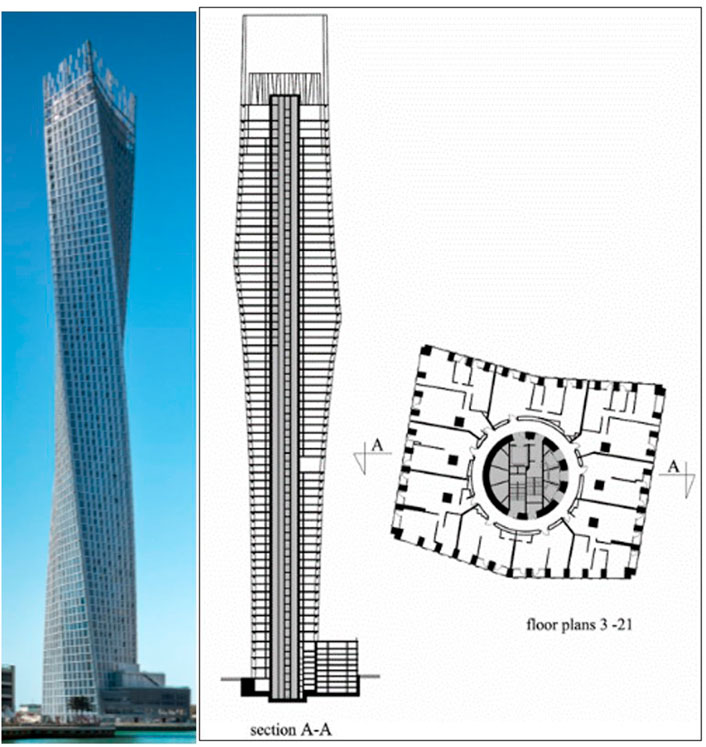
FIGURE 3. Cayan tower dubai (Alkhatib et al., 2022a).
3.1 Wind loads generation
Two versions within the same parametric model are created as illustrated in Figure 4 (a) and (b). The first one is a bluff model representing the exterior shape of the building to be used for CFD wind analysis stage. The other one is element detailed model to be translated into structural model, Figure 4C to be integrated into FE solver for structural responses evaluation during optimization stage.
To set up the CFD environment, different parameters and settings adopted to ensure proper analysis and reliable output. In the first place, domain size of virtual tunnel, shown in Figure 5, was determined based on building height (H) with 2.3 H, 10 H, 2.3 H and 2.3 H for windward, leeward, sides and top, respectively as recommended by (Franke et al., 2007). Blockage ratio was then computed at 1.06%, below the threshold ratio of 5%, to provide sufficient space for the air flow to be fully developed (Mou et al., 2017). The Outflow boundary condition was employed to simulate steady and incompressible wind flow. Wall boundary conditions were used to describe the wall of the computational domain and the surface of the studied building. SIMPLE pressure-velocity coupling algorithms was adopted for solver setting, and Second-Order Upwind Scheme was adopted to discretize momentum, turbulent kinetic energy, and turbulence dissipation rate (Meng et al., 2018). Finally, convergence of simulation is assumed to be reached when residuals of x, y, z momentum, k, ε and continuity are less than 10–3 39.
Realizable k—ε turbulence model was adopted to perform numerical simulation. That is because it is sensitive to rapid strain and streamline curvature, flow separation, re-attachment and recirculation (Ozmen et al., 2016), while at the same time, it allows mathematical constrains to fit Reynolds stresses (Tutar and Oguz, 2002). For mesh resolutions, maximum grid size is determined by dividing shortest width of the building over 10 and multiplying the output result by
The generated wind loads for the typical
3.2 GA structural optimization
To implement the developed genetic algorithm technique in the studied example, several configuration and parameters should be established. That includes problem formulation of the investigated problem to suite the optimization algorithm, coding and decoding strategy and controlling parameters.
3.2.1 Problem formulation
The investigated structure was firstly grouped and arranged to simplify the optimization process. Structure was divided into 5 groups along its height. Group 1, group 2, group 3, group 4 and group 5 represent structural elements from 1st to 15th floor, 16th to 30th floor, 31st to 45th floor, 46th to 60th floor and 61st to 75th floor, respectively as illustrated in Table 1. Since lateral structural system is the aim for this optimization, other structural elements including slab and internal columns are assumed to be constant throughout the height of the structure. Original structural elements are set based on reference structural plan of the case study from (Golasz-Szolomicka and Szolomicki, 2019) and (Marmar et al., 2021) together with engineering experience and judgement. Variation for lower and upper limits are set to be within Eurocode design guidance and standard (Hendy and Smith, 2007). To alleviate long computational processing time by limiting number of design variables, columns and beams are assumed with fixed ratio of 3:2 for depth and width respectively. Thus, sections’ width is changed in proportion to their depth by the fixed ratio. Finally, taking constructability into account, the variance in sections sizes is determined by 25 mm intervals.
Design constraints limitations for structural displacement and inter-story drift are adopted based on Eurocode Standard (Hendy and Smith, 2007). The computed limits are 600 mm and 0.0015 for structural displacement and inter-story drifts, respectively. Top acceleration limit of 0.21 m2/s is generated based on ISO 10137:2007 (ISO Organization for Standardization, 2007) with 1 year return period.
3.2.2 Coding and decoding
Several ways to represent design variables in GA including real and binary values. This research however adopted binary method, as shown in Figure 9, for its highly efficiency uniform crossover (Hu and Di Paolo, 2008), and faster computing time as it deals with machine original language of 0 and 1. For the 15 design variables represented by the assigned groups, change of design variables sectional area were planned in a set of pool with maximum of 625 mm, 150 mm in section size reduction or increment respectively, and within 25 mm intervals. This will produce a set
To produce a binary code for
3.2.3 GA control parameters
The main controlling parameters for genetic algorithm are population size and generations number. Population size projects number of individuals in each generation, and number of generations projects maximum number of iterations for computational process of genetic algorithm, unless convergence is achieved or stopping criteria is activated. Considering the problem given in this case study, size of design variables, computational time and pre-test of the developed algorithm, population size and number of generations were set to be 50 each. After initial population is randomly created and evaluated, the next generation is produced by undergoing through elitism, crossover and mutation process, as shown in Figures 10, 11.
Elitism was adopted in the optimization process because of its effectiveness in improving the efficiency of GA (De Jong, 1975). Elitism is achieved by preserving the highest performance individual solution from one generation to another by simply copying the fittest chromosome to the next generation before all individuals in the population undergo crossover and mutation process.
Crossover methods including single-point, multi-point, uniform and variable-to-variable crossover were tested to find the most effective method for the given optimization problem (Hasançebi and Erbatur, 2000). Multi-point crossover was adopted giving that it has a better logic for the optimization problem in hand. In multi-point crossover, parents’ chromosomes (strings) are decomposed to number of substrings at random locations based on the introduced cutting points (cp). Substrings are then swapped and interchanged between parents to produce new offspring. That allows the algorithm to produce new combination of structural sections along structure groups to be evaluated. Crossover rate which decides the possibility of crossover to happen in a given generation is set to be 0.7 as generally implemented in GA optimization.
Mutation was also applied to introduce and maintain diversity in exploration of new solutions. Bit-flip is the method applied in binary coding problems and it is achieved by randomly selecting one individual chromosome from in a given population and randomly flipping one of its gene’s values (from 0 to 1 and vice versa). Mutation rate which decides the possibility of mutation to happen in a given generation is set to be 0.17 as generally implemented in GA optimization.
3.3 Analysis and discussion
Design optimization cycle started by generating the random population and undergoing evaluation process by implementing the above-mentioned objective function and its design contains mathematical formulations. That is involved both static serviceability analysis and dynamic eigen value analysis. The first critical modes of shape are shown in Figure 12. It is observed that due to the complexity of the building form, critical mode of shapes also shows similar complexity in deformation, which cannot be predicted normally as regular shapes. This proves the necessity of the developed formulation to take into account the deformation in both x and y direction, as well as in their diagonal resulted vector direction.
For each generation, the fittest individual within the population is ranked first and documented. That is to allow its use for the second generation if there is no better solution is found, hence algorithm does not lose the best in hand. Summary of the optimization cycle and its associated objective and constraints values are recorded in Table 2. To minimize the lengthy list of the produced 50 generations, and for better result representation, only generations that experienced a change in their individual solutions output are depicted in Table 2.
Several valuable insights can be discussed from the recorded solutions stipulated in Table 2 above. For the design constraints, it was observed that structural displacement governs the design and optimization, while drift and top acceleration still stand far from their limited values. This provides engineers with valuable information on the critical structural response to be dealt with. Besides, it also opens an opportunity for extended optimization by strengthening the structure to the identified critical response and elevating all other design constraints to the level of their maximum allowable limitations. Furthermore, all penalties values for the best ranked recorded solutions are zeros. That demonstrate the competency of the developed algorithm to exclude all potential solutions which violates the design constraints requirements (Ahmed et al., 2022; Aslam et al., 2022; Faraj et al., 2022).
3.3.1 Optimization of structural sections
Selected structural sections from the pre-defined variation list for different structural elements are assembled to form an individual solution for the lateral system of the structure. Variation of the sections are shown in Figure 13, Figure 14 and Figure 15 for core-wall, columns and beams sections, respectively. It can be noticed that during the first rounds of generations, section varied greatly in sizes to find an optimum combination that represent the objective function. Another observation is that most of the change in sections occurs among core wall sections. That is justified by the importance of core-wall system in resisting lateral loads in comparison to other structural elements (Khan, 2018; Khan et al., 2019; Alkhatib et al., 2021b; Khan, 2021; Najm et al., 2021; Najm et al., 2022).
3.3.2 Optimization of structural sections
Finally, the recorded weight minimization for every generated solution is shown in Figure 16 in terms of the concrete volume for the lateral structural system (Al-Tayeb et al., 2022; Almeshal et al., 2022; Emad et al., 2022; Saeed et al., 2022). After generating the first population, a huge drop of the structural weight is experienced due to the randomness of the first population where optimization algorithm easily can search for the optimal solution with minimum sections. After that, refinement of the selected solutions is generated through selection procedures and evaluation techniques to further optimize the structural until convergence is reached and all generated solution beyond that represent the same section sizes (Khan, 2017; Najem and Ibrahim, 2018).
Optimal sections weight is then compared to the original design to compute the reduction in concrete volume as shown in Table 3. The effectiveness of this optimization approach is validated through the achievable reduction of lateral structural concrete volume by 11,204 cubic meter of concrete that reflects a 36.1% of the total volume from the original sections. Considering the sustainability value in other hand with almost 410 Kg of CO2 emissions is produced for each cubic meter of concrete, the optimization was able to eliminate a total of 4,400 tons of embedded CO2 from this process.
4 Conclusion
This study aimed to extend the research and development of structural optimization with focus on irregular tall buildings subjected to wind motions. The developed approach consists of two major procedures. Firstly, an appropriate computational technique to evaluate wind loads on irregular tall building is proposed. That is achieved by integrating parametrical model into computational fluid dynamic analysis, that is coupled with fluid structure interaction algorithm to produce wind forces. The generated forces are then used as an input, together with gravity forces, to perform structural optimization. Structural optimization is developed in this study by employing genetic algorithm with enhanced constraint’s function. Mathematical formulation of the enhanced design constraints is developed with consideration to lateral displacement, drifts and top acceleration for regular and complex motion that may be accounted due to the irregularity of building. Finite element analysis is then performed for each generated solution to evaluate static and dynamic structural responses against the pre-defined objective function.
Existing case study of 75-story building with irregular twisting shape is performed to validate the feasibility of this research work. Only steady and incompressible flow applied at (
Future studies shall be extended by employing different CFD model including flow type and mesh resolution to improve the accuracy of capturing the wind motions on tall buildings. Moreover, further examination of different evolutionary algorithms, such as Neural Network and Practical Swarm, can be done to measure their effectiveness in dealing with structural optimization problems. Another suggestion, with the benefit of parametrical approach employed in this study, another type of optimization can be developed and integrated within the proposed framework. That includes aerodynamic optimization to mitigate wind motions on the building, and topology optimization. To evaluate different lateral structural system for wind resistance optimal solution.
Data availability statement
The original contributions presented in the study are included in the article/Supplementary Material, further inquiries can be directed to the corresponding author.
Author contributions
Conceptualization, FA, NK, SQ, HN, and MS Methodology, FA, NK, SQ, HN, and MS; software, FA, NK, SQ, HN, and MS; validation, FA, NK, SQ, HN, and MS; formal analysis, FA, NK, SQ, HN, and MS investigation, FA, NK, SQ, HN, and MS; resources, FA, NK, SQ, HN, and MS; data curation, FA, NK, SQ, HN, and MS; writing—original draft preparation, FA, NK, SQ, HN, and MS; writing—review and editing, FA, NK, SQ, HN, and MS; visualization, FA, NK, SQ, HN, and MS; super-vision, FA, NK, SQ, HN, and MS; project administration, MS; funding acquisition, MS. All authors have read and agreed to the published version of the manuscript.
Funding
The research is partially funded by the Ministry of Science and Higher Education of the Russian Federation under the strategic academic leadership program ‘Priority 2030’ (Agreement 075-15-2021-1333 dated 30 September 2021).
Acknowledgments
The authors extend their thanks to the Ministry of Science and Higher Education of the Russian Federation for funding this work.
Conflict of interest
The authors declare that the research was conducted in the absence of any commercial or financial relationships that could be construed as a potential conflict of interest.
Publisher’s note
All claims expressed in this article are solely those of the authors and do not necessarily represent those of their affiliated organizations, or those of the publisher, the editors and the reviewers. Any product that may be evaluated in this article, or claim that may be made by its manufacturer, is not guaranteed or endorsed by the publisher.
References
Abd Elrehim, M. Z., Eid, M. A., and Sayed, M. G. (2019). Structural optimization of concrete arch bridges using genetic algorithms. Ain Shams Eng. J. 10, 507–516. doi:10.1016/j.asej.2019.01.005
Ahmed, S. N., Hamah Sor, N., Ahmed, M. A., and Qaidi, S. M. A. (2022). Thermal conductivity and hardened behavior of eco-friendly concrete incorporating waste polypropylene as fine aggregate. Mater. Today Proc. 57, 818–823. doi:10.1016/j.matpr.2022.02.417
Al-Tayeb, M. M., Aisheh, Y. I. A., Qaidi, S. M. A., and Tayeh, B. A. (2022). Experimental and simulation study on the impact resistance of concrete to replace high amounts of fine aggregate with plastic, Case Stud. Constr. Mater. 17, e01324. doi:10.1016/j.cscm.2022.e01324
Alkhatib, F., Alawag, A. M., and Daris, A. (2021). Building information modelling (BIM) and energy performance of building-A review. J. Appl. Artif. Intell. 2, 22–31. doi:10.48185/jaai.v2i1.581
Alkhatib, F. H., Kasim, N., Goh, W. I., and Al-masoodi, A. H. H. (2022). Performance-driven evaluation and parametrical design approach for sustainable complex-tall building design at conceptual stage. IOP Conf. Ser. Earth Environ. Sci. 1022, 012047. doi:10.1088/1755-1315/1022/1/012047
Alkhatib, F. H., Kasim, N., Goh, W. I., and Al-Masudi, A. A. H. (2021). Multidisciplinary computational optimization: An integrated approach to achieve sustainability in tall building design at early stage-review.” in International Sustainability and Resilience Conference Clim. Change, Malaysia, 2022/05/01, 562
Alkhatib, F., Kasim, N., Goh, W. I., Shafiq, N., Amran, M., Kotov, E. V., et al. (2022). Computational aerodynamic optimization of wind-sensitive irregular tall buildings. Buildings 12, 939. doi:10.3390/buildings12070939
Almeshal, I., Al-Tayeb, M. M., Qaidi, S. M. A., Abu Bakar, B. H., and Tayeh, B. A. (2022). Mechanical properties of eco-friendly cements-based glass powder in aggressive medium materials today. Proceedings 58, 1582. doi:10.1016/j.matpr.2022.03.613
Aslam, F., Zaid, O., Althoey, F., Alyami, S. H., Qaidi, S. M. A., de Prado Gil, J., et al. (2022). Evaluating the influence of fly ash and waste glass on the characteristics of coconut fibers reinforced concrete Structural Concrete n/a.
Atabay, S. (2009). Cost optimization of three-dimensional beamless reinforced concrete shear-wall systems via genetic algorithm. Expert Syst. Appl. 36, 3555–3561. doi:10.1016/j.eswa.2008.02.004
Bairagi, A. K., and Dalui, S. K. (2018). Comparison of aerodynamic coefficients of setback tall buildings due to wind load. Asian J. Civ. Eng. 19, 205–221. doi:10.1007/s42107-018-0018-3
Chan, C.-M., and Chui, J. K. L. (2006). Wind-induced response and serviceability design optimization of tall steel buildings. Eng. Struct. 28, 503–513. doi:10.1016/j.engstruct.2005.09.005
Chan, C.-M., Grierson, D. E., and Sherbourne, A. N. (1995). Automatic optimal design of tall steel building frameworks. J. Struct. Eng. 121, 838–847. doi:10.1061/(asce)0733-9445(1995)121:5(838)
Chan, C. M., Huang, M. F., and Kwok, K. C. S. (2009). Stiffness optimization for wind-induced dynamic serviceability design of tall buildings. J. Struct. Eng. 135, 985–997. doi:10.1061/(asce)st.1943-541x.0000036
De Jong, K. A. (1975). An analysis of the behavior of a class of genetic adaptive systems. University of Michigan.
Elshaer, A., Bitsuamlak, G., and El Damatty, A. (2017). Enhancing wind performance of tall buildings using corner aerodynamic optimization. Eng. Struct. 136, 133–148. doi:10.1016/j.engstruct.2017.01.019
Emad, W., Mohammed, A. S., Bras, A., Asteris, P. G., Kurda, R., Muhammed, Z., et al. (2022). Metamodel techniques to estimate the compressive strength of UHPFRC using various mix proportions and a high range of curing temperatures. Constr. Build. Mater. 349, 128737. doi:10.1016/j.conbuildmat.2022.128737
Faraj, R. H., Ahmed, H. U., Rafiq, S., Sor, N. H., Ibrahim, D. F., and Qaidi, S. M. A. (2022). Performance of self-compacting mortars modified with nanoparticles: A systematic review and modeling. Clean. Mater. 4, 100086. doi:10.1016/j.clema.2022.100086
Franke, J., Hellsten, A., Schlünzen, K. H., and Carissimo, B. (2007). “Best practice guideline for the CFD simulation of flows in the urban environment-a summary,” in 11th conference on harmonisation within atmospheric dispersion modelling for regulatory purposes, United Kingdom, July 2007 Cambridge, UK.
Fu, J.-Y., Wu, B.-G., Xu, A., Wu, J.-R., and Pi, Y.-L. (2018). A new method for frequency constrained structural optimization of tall buildings under wind loads. Struct. Des. Tall Spec. Build. 27, e1549. doi:10.1002/tal.1549
Golasz-Szolomicka, H., and Szolomicki, J. (2019). Architectural and structural analysis of selected twisted tall buildings. IOP Conf. Ser. Mat. Sci. Eng. 471, 052050. doi:10.1088/1757-899x/471/5/052050
Hasançebi, O., and Erbatur, F. (2000). Evaluation of crossover techniques in genetic algorithm based optimum structural design. Comput. Struct. 78, 435–448. doi:10.1016/s0045-7949(00)00089-4
Hassanli, S., Hu, G., Fletcher, D. F., and Kwok, K. C. S. (2018). Potential application of double skin façade incorporating aerodynamic modifications for wind energy harvesting. J. Wind Eng. Industrial Aerodynamics 174, 269–280. doi:10.1016/j.jweia.2018.01.016
Hendy, C. R., and Smith, D. A. (2007). Designers’ guide to EN 1992-2.” in Eurocode 2: Design of Concrete Structures: Part 2: Concrete Bridges, 17. London: Thomas Telford.
Hu, X.-B., and Di Paolo, E. (2008). Binary-representation-based genetic algorithm for aircraft arrival sequencing and scheduling. IEEE Trans. Intell. Transp. Syst. 9, 301–310. doi:10.1109/tits.2008.922884
Huang, M. F., Li, Q., Chan, C., Lou, W., Kwok, K., and Li, G. (2015). Performance-based design optimization of tall concrete framed structures subject to wind excitations. J. Wind Eng. Industrial Aerodynamics 139, 70–81. doi:10.1016/j.jweia.2015.01.005
ISO Organization for Standardization (2007). Bases for design of structures--serviceability of buildings and walkways against vibrations. Goldberg, Geneva: ISO.
I S O. (1984). Guidelines for the evaluation of the response of occupants of fixed structures, especially buildings and off-shore structures, to low-frequency horizontal motion (0·063 to 1Hz). The International Organization for Standardization.
Khan, M. A. (2017). Capturing failures in steel-plated RC beams through a combination of discrete and continuum models Materials Today. Proceedings 4, 9752. doi:10.1016/j.matpr.2017.06.261
Khan, M. A., Irfan, S., Rizvi, Z., and Ahmad, J. (2019). A numerical study on the validation of thermal formulations towards the behaviour of RC beams Materials Today. Proceedings 17, 227. doi:10.1016/j.matpr.2019.06.423
Khan, M. A. (2021). Toward key research gaps in design recommendations on flexurally plated RC beams susceptible to premature failures. J. Bridge Eng. 26, 04021067. doi:10.1061/(asce)be.1943-5592.0001772
Khan, M. A. (2018). Understanding the brittleness of failures in composite RC beam plated at soffit. Mater. Today Proc. 5, 24085–24093. doi:10.1016/j.matpr.2018.10.202
Kim, Y.-M., and You, K.-P. (2002). Dynamic responses of a tapered tall building to wind loads. J. Wind Eng. Industrial Aerodynamics 90, 1771–1782. doi:10.1016/s0167-6105(02)00286-6
Kim, Y.-M., You, K.-P., and Ko, N.-H. (2008). Across-wind responses of an aeroelastic tapered tall building. J. Wind Eng. Industrial Aerodynamics 96, 1307–1319. doi:10.1016/j.jweia.2008.02.038
Li, Y., Tian, X., Tee, K. F., Li, Q.-S., and Li, Y.-G. (2018). Aerodynamic treatments for reduction of wind loads on high-rise buildings. J. Wind Eng. Industrial Aerodynamics 172, 107–115. doi:10.1016/j.jweia.2017.11.006
Mandal, S., Dalui, S. K., and Bhattacharjya, S. (2021). Wind induced response of corner modified’U’plan shaped tall building. Wind Struct. 32, 521. doi:10.12989/was.2021.32.6.521
Marmar, A., Zouia, S., Ismail, S., and Hallik, A. (2021). Twisted buildings: Concepts and approaches. Archit. Plan. J. 27, 9.
Melbourne, W. H., and Palmer, T. R. (1992). Accelerations and comfort criteria for buildings undergoing complex motions. J. Wind Eng. Industrial Aerodynamics 41, 105–116. doi:10.1016/0167-6105(92)90398-t
Meng, F. Q., He, B. J., Zhu, J., Zhao, D. X., Darko, A., and Zhao, Z. Q. (2018). Sensitivity analysis of wind pressure coefficients on CAARC standard tall buildings in CFD simulations. J. Build. Eng. 16, 146–158. doi:10.1016/j.jobe.2018.01.004
Ming-feng, H. (2013). Wind-induced vibration performance-based optimal structural design of tall buildings. Engineer. Mechanics. 30, 240. doi:10.6052/j.issn.1000-4750.2011.08.0519
Mou, B., He, B.-J., Zhao, D.-X., and Chau, K. (2017). Numerical simulation of the effects of building dimensional variation on wind pressure distribution. Eng. Appl. Comput. Fluid Mech. 11, 293–309. doi:10.1080/19942060.2017.1281845
Najem, H. M., and Ibrahim, A. M. (2018). Influence of concrete strength on the cycle performance of composite steel plate shear walls diyala. J. Eng. Sci. 11, 1. doi:10.24237/djes.2018.11401
Najm, H. M., Ahmad, S., and Submitter, Y. (2021). Artificial neural networks for evaluation & prediction of the mechanical properties of waste ceramic optimal concrete exposed to elevated temperature. Social Science Research Network. Available at SSRN 4032028.
Najm, H. M., Ibrahim, A. M., Sabri, M. M., Hassan, A., Morkhade, S., Mashaan, N. S., et al. (2022). Modelling of cyclic load behaviour of smart composite steel-concrete shear wall using finite element analysis buildings, 12, 850. MDPI
Ozmen, Y., Baydar, E., and Van Beeck, J. (2016). Wind flow over the low-rise building models with gabled roofs having different pitch angles. Build. Environ. 95, 63–74. doi:10.1016/j.buildenv.2015.09.014
Paul, R., and Dalui, S. (2021). Shape optimization to reduce wind pressure on the surfaces of a rectangular building with horizontal limbs. Period. Polytech. Civ. Eng. 65, 134. doi:10.3311/PPci.16888
Pezeshk, S., Camp, C. V., and Chen, D. (2000). Design of nonlinear framed structures using genetic optimization. J. Struct. Eng. 126, 382–388. doi:10.1061/(asce)0733-9445(2000)126:3(382)
Ruiz, C. A., Kalkman, I., and Blocken, B. (2021). Aerodynamic design optimization of ducted openings through high-rise buildings for wind energy harvesting. Build. Environ. 202, 108028. doi:10.1016/j.buildenv.2021.108028
Saeed, A., Najm, H. M., Hassan, A., Qaidi, S., Sabri, M. M. S., and Mashaan, N. S. (2022). A comprehensive study on the effect of regular and staggered openings on the seismic performance of shear walls buildings 12 1293. MDPI
Sanyal, P., and Dalui, S. K. (2022). Forecasting of aerodynamic coefficients of tri-axially symmetrical Y plan shaped tall building based on CFD data trained ANN. J. Build. Eng. 47, 103889. doi:10.1016/j.jobe.2021.103889
Sharma, A., Mittal, H., and Gairola, A. (2018). Mitigation of wind load on tall buildings through aerodynamic modifications: Review. J. Build. Eng. 18, 180–194. doi:10.1016/j.jobe.2018.03.005
Soegiarso, R., and Adeli, H. (1997). Optimum load and resistance factor design of steel space-frame structures. J. Struct. Eng. 123, 184–192. doi:10.1061/(asce)0733-9445(1997)123:2(184)
Tamura, T., Miyagi, T., and Kitagishi, T. (1998). Numerical prediction of unsteady pressures on a square cylinder with various corner shapes. J. Wind Eng. Industrial Aerodynamics 74, 531–542. doi:10.1016/s0167-6105(98)00048-8
Thordal, M. S., Bennetsen, J. C., Capra, S., Kragh, A. K., and Koss, H. H. H. (2020). Towards a standard CFD setup for wind load assessment of high-rise buildings: Part 2-Blind test of chamfered and rounded corner high-rise buildings. J. Wind Eng. Industrial Aerodynamics 205, 104282. doi:10.1016/j.jweia.2020.104282
Tutar, M., and Oguz, G. (2002). Large eddy simulation of wind flow around parallel buildings with varying configurations. Fluid Dyn. Res. 31, 289–315. doi:10.1016/s0169-5983(02)00127-2
Weller, H. G., Tabor, G., Jasak, H., and Fureby, C. (1998). A tensorial approach to computational continuum mechanics using object-oriented techniques. Comput. Phys. 12, 620–631. doi:10.1063/1.168744
Xie, J. (2014). Aerodynamic optimization of super-tall buildings and its effectiveness assessment. J. Wind Eng. Industrial Aerodynamics 130, 88–98. doi:10.1016/j.jweia.2014.04.004
Zhengwei, Z., Yonga, Q., Minga, G., Nankuna, T., and Yongc, X. (2012). “Effects of corner recession modification on aerodynamic coefficients of square tall buildings,” in The seventh international colloquium on bluff body aerodynamics and applications. (Shangha: The International Association for Wind Engineering (IAWE))
Keywords: genetic algorithm, optimization, wind-resistant, computational fluid dynamic, computational fluid dynamics modeling
Citation: Alkhatib F, Kasim N, Qaidi S, Najm HM and Sabri Sabri MM (2022) Wind-resistant structural optimization of irregular tall building using CFD and improved genetic algorithm for sustainable and cost-effective design. Front. Energy Res. 10:1017813. doi: 10.3389/fenrg.2022.1017813
Received: 12 August 2022; Accepted: 22 September 2022;
Published: 11 October 2022.
Edited by:
M. Arsalan Khan, Aligarh Muslim University, IndiaReviewed by:
Osama Alazzawi, Huazhong University of Science and Technology, ChinaAhmed Elshaer, Lakehead University, Canada
Copyright © 2022 Alkhatib, Kasim, Qaidi, Najm and Sabri Sabri. This is an open-access article distributed under the terms of the Creative Commons Attribution License (CC BY). The use, distribution or reproduction in other forums is permitted, provided the original author(s) and the copyright owner(s) are credited and that the original publication in this journal is cited, in accordance with accepted academic practice. No use, distribution or reproduction is permitted which does not comply with these terms.
*Correspondence: Fadi Alkhatib, YWxraGF0aWJmYWRpOTBAZ21haWwuY29t
 Fadi Alkhatib
Fadi Alkhatib Narimah Kasim
Narimah Kasim Shaker Qaidi
Shaker Qaidi Hadee Mohammed Najm
Hadee Mohammed Najm Mohanad Muayad Sabri Sabri
Mohanad Muayad Sabri Sabri